[TOC]
概要:
一、Dubbo 调用非典型使用场景
二、调用内部实现源码分析
## 一、Dubbo 调用非典型使用场景
---
### **泛化提供&引用**
**泛化提供**
是指不通过接口的方式直接将服务暴露出去。通常用于Mock框架或服务降级框架实现。
#TODO 示例演示
```
public static void doExportGenericService() {
ApplicationConfig applicationConfig = new ApplicationConfig();
applicationConfig.setName("demo-provider");
// 注册中心
RegistryConfig registryConfig = new RegistryConfig();
registryConfig.setProtocol("zookeeper");
registryConfig.setAddress("192.168.0.147:2181");
ProtocolConfig protocol=new ProtocolConfig();
protocol.setPort(-1);
protocol.setName("dubbo");
GenericService demoService = new MyGenericService();
ServiceConfig<GenericService> service = new ServiceConfig<GenericService>();
// 弱类型接口名
service.setInterface("com.tuling.teach.service.DemoService");
// 指向一个通用服务实现
service.setRef(demoService);
service.setApplication(applicationConfig);
service.setRegistry(registryConfig);
service.setProtocol(protocol);
// 暴露及注册服务
service.export();
}
```
**泛化引用**
是指不通过常规接口的方式去引用服务,通常用于测试框架。
```
ApplicationConfig applicationConfig = new ApplicationConfig();
applicationConfig.setName("demo-provider");
// 注册中心
RegistryConfig registryConfig = new RegistryConfig();
registryConfig.setProtocol("zookeeper");
registryConfig.setAddress("192.168.0.147:2181");
// 引用远程服务
ReferenceConfig<GenericService> reference = new ReferenceConfig<GenericService>();
// 弱类型接口名
reference.setInterface("com.tuling.teach.service.DemoService");
// 声明为泛化接口
reference.setGeneric(true);
reference.setApplication(applicationConfig);
reference.setRegistry(registryConfig);
// 用com.alibaba.dubbo.rpc.service.GenericService可以替代所有接口引用
GenericService genericService = reference.get();
Object result = genericService.$invoke("sayHello", new String[]{"java.lang.String"}, new Object[]{"world"});
```
### **隐示传参**
是指通过非常方法参数传递参数,类似于http 调用当中添加cookie值。通常用于分布式追踪框架的实现。使用方式如下 :
```
//客户端隐示设置值
RpcContext.getContext().setAttachment("index", "1"); // 隐式传参,后面的远程调用都会隐
//服务端隐示获取值
String index = RpcContext.getContext().getAttachment("index");
```
### **令牌验证**
通过令牌验证在注册中心控制权限,以决定要不要下发令牌给消费者,可以防止消费者绕过注册中心访问提供者,另外通过注册中心可灵活改变授权方式,而不需修改或升级提供者

使用:
```
<!--随机token令牌,使用UUID生成--><dubbo:provider interface="com.foo.BarService" token="true" />
```
### **过滤器**
类似于 WEB 中的Filter ,Dubbo本身提供了Filter 功能用于拦截远程方法的调用。其支持自定义过滤器与官方的过滤器使用**:**
#TODO 演示添加日志访问过滤:
```
<dubbo:provider filter="accesslog" accesslog="logs/dubbo.log"/>
```
以上配置 就是 为 服务提供者 添加 日志记录过滤器, 所有访问日志将会集中打印至 accesslog 当中
**自定义过滤器:**
1、编写过滤器
```
package com.tuling.dubbo;
import org.apache.dubbo.common.constants.CommonConstants;
import org.apache.dubbo.common.extension.Activate;
import org.apache.dubbo.rpc.*;
@Activate(group = {CommonConstants.PROVIDER})
public class ProviderHelloFilter implements Filter {
@Override
public Result invoke(Invoker<?> invoker, Invocation invocation) throws RpcException {
System.out.println("hello ok====================================>>>>>");
return invoker.invoke(invocation);
}
}
```
添加扩展点:
创建文件路径如下:
```
# 文件路径
META-INF/dubbo/org.apache.dubbo.rpc.Filter
#内容:
helloFilter=com.tuling.dubbo.ProviderHelloFilter
```
## 二 、调用内部实现源码分析
---
**知识点**
1. 分析代理类
2. 分析类结构
3. 初始化过程
1. 分析代理类
在调用服务端时,是接口的形式进行调用,该接口是Duboo 动态代理之后的实现,通过反编译工具可以查看到其具体实现:
因为类是代理生成,所以采用[arthas](https://github.com/alibaba/arthas)工具来反编译,具体操作如下:
```
#运行 arthas
java -jar arthas-boot.jar
#扫描类
sc *.proxy0
#反编译代理类
jad com.alibaba.dubbo.common.bytecode.proxy0
```
反编译的代码如下:
```
/*
* Decompiled with CFR.
*
* Could not load the following classes:
* com.tuling.client.User
* com.tuling.client.UserService
*/
package org.apache.dubbo.common.bytecode;
import com.alibaba.dubbo.rpc.service.EchoService;
import com.tuling.client.User;
import com.tuling.client.UserService;
import java.lang.reflect.InvocationHandler;
import java.lang.reflect.Method;
import java.util.List;
import org.apache.dubbo.common.bytecode.ClassGenerator;
public class proxy0
implements ClassGenerator.DC,
EchoService,
UserService {
public static Method[] methods;
private InvocationHandler handler;
public List findUser(String string, String string2) {
Object[] arrobject = new Object[]{string, string2};
Object object = this.handler.invoke(this, methods[0], arrobject);
return (List)object;
}
public User getUser(Integer n) {
Object[] arrobject = new Object[]{n};
Object object = this.handler.invoke(this, methods[1], arrobject);
return (User)object;
}
@Override
public Object $echo(Object object) {
Object[] arrobject = new Object[]{object};
Object object2 = this.handler.invoke(this, methods[2], arrobject);
return object2;
}
public proxy0() {
}
public proxy0(InvocationHandler invocationHandler) {
this.handler = invocationHandler;
}
}
```
可看出其代理实现了 UserService 接口。并且基于InvocationHandler 进行代理。实际类是 InvokerInvocationHandler 并且其中之属性为Invoker.。也就是说最终会调用Invoker进行远程调用。
### 2.Dubbo调用流程:
基础流程:

1. 客户端调用
2. 透明代理
3. 负载均衡
4. 容错
5. 异步转同步
6. 获取结果
7. 服务端响应
1. 分析类结构关系
* prxoy$: 代理类
* Invoker: 执行器
* Invocation: 执行参数与环境
* Result:返回结果
* Protocol:协议
##

- 一.JVM
- 1.1 java代码是怎么运行的
- 1.2 JVM的内存区域
- 1.3 JVM运行时内存
- 1.4 JVM内存分配策略
- 1.5 JVM类加载机制与对象的生命周期
- 1.6 常用的垃圾回收算法
- 1.7 JVM垃圾收集器
- 1.8 CMS垃圾收集器
- 1.9 G1垃圾收集器
- 2.面试相关文章
- 2.1 可能是把Java内存区域讲得最清楚的一篇文章
- 2.0 GC调优参数
- 2.1GC排查系列
- 2.2 内存泄漏和内存溢出
- 2.2.3 深入理解JVM-hotspot虚拟机对象探秘
- 1.10 并发的可达性分析相关问题
- 二.Java集合架构
- 1.ArrayList深入源码分析
- 2.Vector深入源码分析
- 3.LinkedList深入源码分析
- 4.HashMap深入源码分析
- 5.ConcurrentHashMap深入源码分析
- 6.HashSet,LinkedHashSet 和 LinkedHashMap
- 7.容器中的设计模式
- 8.集合架构之面试指南
- 9.TreeSet和TreeMap
- 三.Java基础
- 1.基础概念
- 1.1 Java程序初始化的顺序是怎么样的
- 1.2 Java和C++的区别
- 1.3 反射
- 1.4 注解
- 1.5 泛型
- 1.6 字节与字符的区别以及访问修饰符
- 1.7 深拷贝与浅拷贝
- 1.8 字符串常量池
- 2.面向对象
- 3.关键字
- 4.基本数据类型与运算
- 5.字符串与数组
- 6.异常处理
- 7.Object 通用方法
- 8.Java8
- 8.1 Java 8 Tutorial
- 8.2 Java 8 数据流(Stream)
- 8.3 Java 8 并发教程:线程和执行器
- 8.4 Java 8 并发教程:同步和锁
- 8.5 Java 8 并发教程:原子变量和 ConcurrentMap
- 8.6 Java 8 API 示例:字符串、数值、算术和文件
- 8.7 在 Java 8 中避免 Null 检查
- 8.8 使用 Intellij IDEA 解决 Java 8 的数据流问题
- 四.Java 并发编程
- 1.线程的实现/创建
- 2.线程生命周期/状态转换
- 3.线程池
- 4.线程中的协作、中断
- 5.Java锁
- 5.1 乐观锁、悲观锁和自旋锁
- 5.2 Synchronized
- 5.3 ReentrantLock
- 5.4 公平锁和非公平锁
- 5.3.1 说说ReentrantLock的实现原理,以及ReentrantLock的核心源码是如何实现的?
- 5.5 锁优化和升级
- 6.多线程的上下文切换
- 7.死锁的产生和解决
- 8.J.U.C(java.util.concurrent)
- 0.简化版(快速复习用)
- 9.锁优化
- 10.Java 内存模型(JMM)
- 11.ThreadLocal详解
- 12 CAS
- 13.AQS
- 0.ArrayBlockingQueue和LinkedBlockingQueue的实现原理
- 1.DelayQueue的实现原理
- 14.Thread.join()实现原理
- 15.PriorityQueue 的特性和原理
- 16.CyclicBarrier的实际使用场景
- 五.Java I/O NIO
- 1.I/O模型简述
- 2.Java NIO之缓冲区
- 3.JAVA NIO之文件通道
- 4.Java NIO之套接字通道
- 5.Java NIO之选择器
- 6.基于 Java NIO 实现简单的 HTTP 服务器
- 7.BIO-NIO-AIO
- 8.netty(一)
- 9.NIO面试题
- 六.Java设计模式
- 1.单例模式
- 2.策略模式
- 3.模板方法
- 4.适配器模式
- 5.简单工厂
- 6.门面模式
- 7.代理模式
- 七.数据结构和算法
- 1.什么是红黑树
- 2.二叉树
- 2.1 二叉树的前序、中序、后序遍历
- 3.排序算法汇总
- 4.java实现链表及链表的重用操作
- 4.1算法题-链表反转
- 5.图的概述
- 6.常见的几道字符串算法题
- 7.几道常见的链表算法题
- 8.leetcode常见算法题1
- 9.LRU缓存策略
- 10.二进制及位运算
- 10.1.二进制和十进制转换
- 10.2.位运算
- 11.常见链表算法题
- 12.算法好文推荐
- 13.跳表
- 八.Spring 全家桶
- 1.Spring IOC
- 2.Spring AOP
- 3.Spring 事务管理
- 4.SpringMVC 运行流程和手动实现
- 0.Spring 核心技术
- 5.spring如何解决循环依赖问题
- 6.springboot自动装配原理
- 7.Spring中的循环依赖解决机制中,为什么要三级缓存,用二级缓存不够吗
- 8.beanFactory和factoryBean有什么区别
- 九.数据库
- 1.mybatis
- 1.1 MyBatis-# 与 $ 区别以及 sql 预编译
- Mybatis系列1-Configuration
- Mybatis系列2-SQL执行过程
- Mybatis系列3-之SqlSession
- Mybatis系列4-之Executor
- Mybatis系列5-StatementHandler
- Mybatis系列6-MappedStatement
- Mybatis系列7-参数设置揭秘(ParameterHandler)
- Mybatis系列8-缓存机制
- 2.浅谈聚簇索引和非聚簇索引的区别
- 3.mysql 证明为什么用limit时,offset很大会影响性能
- 4.MySQL中的索引
- 5.数据库索引2
- 6.面试题收集
- 7.MySQL行锁、表锁、间隙锁详解
- 8.数据库MVCC详解
- 9.一条SQL查询语句是如何执行的
- 10.MySQL 的 crash-safe 原理解析
- 11.MySQL 性能优化神器 Explain 使用分析
- 12.mysql中,一条update语句执行的过程是怎么样的?期间用到了mysql的哪些log,分别有什么作用
- 十.Redis
- 0.快速复习回顾Redis
- 1.通俗易懂的Redis数据结构基础教程
- 2.分布式锁(一)
- 3.分布式锁(二)
- 4.延时队列
- 5.位图Bitmaps
- 6.Bitmaps(位图)的使用
- 7.Scan
- 8.redis缓存雪崩、缓存击穿、缓存穿透
- 9.Redis为什么是单线程、及高并发快的3大原因详解
- 10.布隆过滤器你值得拥有的开发利器
- 11.Redis哨兵、复制、集群的设计原理与区别
- 12.redis的IO多路复用
- 13.相关redis面试题
- 14.redis集群
- 十一.中间件
- 1.RabbitMQ
- 1.1 RabbitMQ实战,hello world
- 1.2 RabbitMQ 实战,工作队列
- 1.3 RabbitMQ 实战, 发布订阅
- 1.4 RabbitMQ 实战,路由
- 1.5 RabbitMQ 实战,主题
- 1.6 Spring AMQP 的 AMQP 抽象
- 1.7 Spring AMQP 实战 – 整合 RabbitMQ 发送邮件
- 1.8 RabbitMQ 的消息持久化与 Spring AMQP 的实现剖析
- 1.9 RabbitMQ必备核心知识
- 2.RocketMQ 的几个简单问题与答案
- 2.Kafka
- 2.1 kafka 基础概念和术语
- 2.2 Kafka的重平衡(Rebalance)
- 2.3.kafka日志机制
- 2.4 kafka是pull还是push的方式传递消息的?
- 2.5 Kafka的数据处理流程
- 2.6 Kafka的脑裂预防和处理机制
- 2.7 Kafka中partition副本的Leader选举机制
- 2.8 如果Leader挂了的时候,follower没来得及同步,是否会出现数据不一致
- 2.9 kafka的partition副本是否会出现脑裂情况
- 十二.Zookeeper
- 0.什么是Zookeeper(漫画)
- 1.使用docker安装Zookeeper伪集群
- 3.ZooKeeper-Plus
- 4.zk实现分布式锁
- 5.ZooKeeper之Watcher机制
- 6.Zookeeper之选举及数据一致性
- 十三.计算机网络
- 1.进制转换:二进制、八进制、十六进制、十进制之间的转换
- 2.位运算
- 3.计算机网络面试题汇总1
- 十四.Docker
- 100.面试题收集合集
- 1.美团面试常见问题总结
- 2.b站部分面试题
- 3.比心面试题
- 4.腾讯面试题
- 5.哈罗部分面试
- 6.笔记
- 十五.Storm
- 1.Storm和流处理简介
- 2.Storm 核心概念详解
- 3.Storm 单机版本环境搭建
- 4.Storm 集群环境搭建
- 5.Storm 编程模型详解
- 6.Storm 项目三种打包方式对比分析
- 7.Storm 集成 Redis 详解
- 8.Storm 集成 HDFS 和 HBase
- 9.Storm 集成 Kafka
- 十六.Elasticsearch
- 1.初识ElasticSearch
- 2.文档基本CRUD、集群健康检查
- 3.shard&replica
- 4.document核心元数据解析及ES的并发控制
- 5.document的批量操作及数据路由原理
- 6.倒排索引
- 十七.分布式相关
- 1.分布式事务解决方案一网打尽
- 2.关于xxx怎么保证高可用的问题
- 3.一致性hash原理与实现
- 4.微服务注册中心 Nacos 比 Eureka的优势
- 5.Raft 协议算法
- 6.为什么微服务架构中需要网关
- 0.CAP与BASE理论
- 十八.Dubbo
- 1.快速掌握Dubbo常规应用
- 2.Dubbo应用进阶
- 3.Dubbo调用模块详解
- 4.Dubbo调用模块源码分析
- 6.Dubbo协议模块
